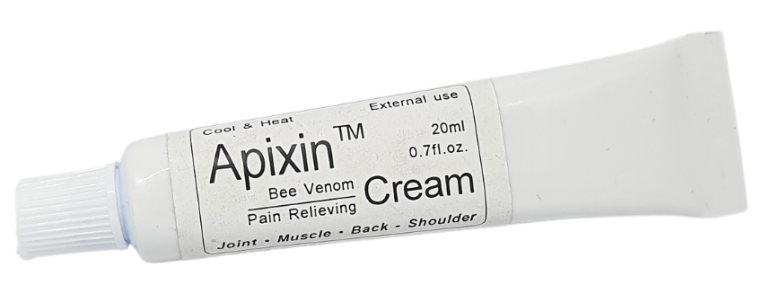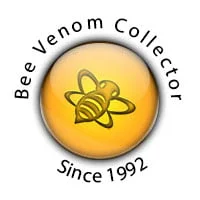THE BEE VENOM AND HUMANS
Iliya Kanchev, Ph.D.
-
-
- Effect of bee venom on humans
- The healing effect of bee venom
Effect of bee venom on humans
The effect of bee venom on humans is highly individual.
The typical effect is the following:
An allergic reaction occurs in most of the people after 1 sting. This reaction occurs immediately or in 4-5 hours at the latest after the sting. In the case of 200-300 simultaneous stings, a toxic reaction is observed in humans. 500 simultaneous stings may lead to death as a result of respiratory system paralysis in humans.
In order to avoid or decrease considerably bee stings, the following good suggestions may help.
You can apply lavender oil, castor oil, and peppermint oil on uncovered body parts or just rub peppermint leaves all over your body.
Bees are quite irritated by the strong odor of alcohol, garlic, petrol, paraffin oil, and diesel. They do not like perfumes with sugary fragrances as well.
Never wave your hands and move as slowly and gracefully as you can when being close to bees. Do your best to remain calm whatever happens. Bees may feel our tension, excitement, and nervousness even if we do not visibly display them. That is why it is important to keep peace of mind whatever is going on.
In case of a sting, it is very useful to do the following:
First, we have to pull the sting out of the affected spot. You can best use tweezers. Then, you can put ammonium chloride dissolved in alcohol, onion juice, garlic tarragon, or just pure alcohol on the spot. These means partly destroy the venom.
Hypersensitivity to bee venom is observed in 0.5 – 2 % of people.
When working with bee venom, you must use protective breathing masks and protective eyeglasses.
The bee sting is a self-defense organ. When the bee uses its sting, it dies most frequently as the bee cannot pull it out of the stung place. What is interesting is that when the bee stings warm-blooded animals, it dies. Whereas when the bee stings insects, it does not die. Insects die from bee venom almost immediately, while mice live for about 1-2 hours.
The healing effect of bee venom
Bee venom as a medicine has been used since ancient times. A medicine, containing bee venom and honey has been used for baldness treatment and hair growth stimulation in the remote past. It is a well-known fact that the Russian King Ivan the Terrible and the Swedish king Charles XII have used bee venom as an ingredient for gout treatment.
Nevertheless, it should be remembered that when unskillfully and incorrectly used as a medicine, it can cause considerable damage. No one should use bee venom on the human body without the respective theoretical basis, practical training, and enough clinical surveillance. That may be life-threatening.
Bee venom drugs affect the human body by reducing acute pains and inflammation in rheumatoid arthritis and radiculitis. They are used for the treatment of sciatica, inflammation of the sciatic nerve, and various neuroses; they have a tonic effect on cardiac muscle, reduce blood clotting, and raise hemoglobin levels.
The healing effect of bee venom. (5)
- Nervous system
- In small doses, it has a stimulating effect, and in large doses – it has a comforting effect.
- Expressed analgetic effect
- Anticonvulsant effect
- Improves mood, memory, sleep
- Reduces alcohol and nicotine dependence
- Improves blood flow in the brain
- Cardiovascular system
- Vasodilatory effect; reduces blood pressure
- Improves heart health
- Anticoagulant effect
- Antiplatelet effect
- Increases the volume of circulating blood
- Antiarrhythmic effect
- Antianaemic effect
- Respiratory system
- Dilates bronchi
- Expectorant effect
- Gastrointestinal tract
- Stimulates peristalsis
- Antiulcer effect
Dried natural bee venom is used for the production of pharmaceutical preparations containing bee venom. There is a special technology to purify bee venom, aimed at the separation of the most aggressive components that can cause side effects, such as allergies and intoxication. This purified bee venom has a considerably better effect on the human body’s health. However, there is a possibility that some patients are intolerant to bee venom.
-
Bibliography:
- Чудаков В.Г. Технология продуктов пчеловодства. – М.: Колос, 1979. – 200 с.
- ТУ 46 РСФСР 67-72 «Яд пчелиный сырец» и Фармакопейной статьей ФС 42-2683-89.
- Хомутов А.Е., Калашникова Л.М. Физиологические аспекты получения пчелиного яда // Апитерапия сегодня. – Рыбное, 1997. – с. 18-20
- Руководсто по апитерапии (лечение пчелиным ядом, мёдом, прополисом, цветочной пыльцой и другими продуктами пчеловодства) для врачей, студентов медицинских вузов и пчеловодов / Э. А. Лудянский. – Вологда : [ПФ “Полиграфист”], 1994. – 462 с.
- Апитерапия. / Хисматуллина Н.3. – Пермь: Мобиле, 2005. – 296 с.
- Апитерапия: продукты пчеловодства в мире медицины. / Омаров Ш.М. – Ростов н/Д : Феникс, 2009. – 351 с.
- Гиниятуллин Н.Г., Ильбульдин Ю.Ф. Влияние отдельных факторов на качество пчелиного яда // Апитерапия сегодня. – Рыбное, 1993.
- Мусаев Ф.Г. Биологическое обоснование приемов получения яда от медоносных пчел: Автореф. дис. канд. биол. н-к. – Баку, 1982. – 17 с.
- Кривцов Н.И., Лебедев В.И. Получение и использование продуктов пчеловодства. – М.: Нива России, 1993. – 285 с
- НОВОСИБИРСКИЙ ГОСУДАРСТВЕННЫЙ АГРАРНЫЙ УНИВЕРСИТЕТ ИНСТИТУТ ЗАОЧНОГО ОБРАЗОВАНИЯ И ПОВЫШЕНИЯ КВАЛИФИКАЦИИ “ТЕХНОЛОГИЯ ПРОИЗВОДСТВА БИОЛОГИЧЕСКИ АКТИВНЫХ ПРОДУКТОВ ПЧЕЛОВОДСТВА” – Учебное пособие
Honey Bee Venom
Iliya Kanchev, Ph.D.
-
-
- Production and Components
- Collecting bee venom
- Storage
Production and Components
Bee venom is a colorless thickened liquid with a pungent odor and bitter-hot taste. (10) It is produced at the moment of stinging when the secretion from the small venom gland comes in contact with that of the large venom gland. The length of the venom glands depends on the breed of the bee. The breed also determines the age at which the bee starts producing venom.
Usually, the bee workers can start producing venom after 1 week of age. They are most active between 2 and 3 weeks of age. The bee venom is composed of the following (1) :
melittin 40-50%
apamin 3.4-5.1 %
other peptides up to 16%
hyaluronidase 20%
phospholipase А 14%
amino acids up to 1%
histamine 0.5% -1.7%
fats and sterols up to 5%
glucose 0.5%
fructose 0.9%
organic acid 0.04% – 0.14%
other components 4% -10%
Collecting Bee Venom
The venom can be collected without harm to the bees just by using the secretion from the small and large venom glands. Collecting venom regularly by stimulating the bees to sting can lead to the bees producing twice the amount of venom that they would have normally produced. During its lifespan, a bee can produce up to 0.3mg of venom. The methods of venom collection are based on the principle of introducing an irritant that makes the bee sting. Currently, the most common method for collecting venom is by using an electric charge that stimulates the bee to sting. In the past, people were using an electric charge but it wasn’t possible to control its magnitude and thus preserve the wellbeing of the bees. Today, the most advanced devices for stimulation via electric charges, such as the Collector–beeWhisper have a microprocessor that controls the electric charge so it doesn’t harm the bees and keeps them alive. The bee death rate has been reduced to zero.
Bee venom can be collected inside or outside of the beehive. In order to avoid stressing the bees and preserve the well-being of the bee colony as well as its ability to produce honey and other apian products, we need to use the method of collecting venom outside of the beehive. The electronic microprocessor device Bee Venom Collector – BVC, can be used outside of the beehive. However, some beekeepers still choose to remove the roof of the beehive and put the electronic device above the honeycomb. This is still the better option as compared to putting the device inside the beehive in the place of the honeycomb. If the venom collector is placed between the honeycombs, this will shock the bees. It will make them hyperactive and will cause them to cluster around the device, increasing the temperature in the beehive significantly. In the hot summer days, this can easily result in heat strokes and eventually in the death of the bees.
When we use the Collector – BVC, the venom dries out on the glass panel while the venom is still being collected. In most cases when the air outside is dry, it is not necessary to place the collector under a shade and wait for the venom to dry out before scraping it off the glass panel. If the air humidity is more than 70%, then the glass panels with the venom need to be placed under a shade for 20-30 minutes in order for the venom to dry out. When it’s dry, the venom can be easily scraped off with the special scraper included in the kit.
During the process of drying, the loss of venom weight should be no more than 12%. The part insoluble in water should be no more than 13%. (2) The glass panels should be sterilized with 70-90% ethyl alcohol.
When the air humidity is too high – after rain or when it’s foggy outside, it is not recommended to use an electric charge to stimulate the bees. When the air is humid, the bees become much better conductors of electricity, and therefore an electric charge can harm them easily. The Collector – BVC, www.beewhisper.com, detects the level of air humidity and automatically adjusts the magnitude of the electric charge or suspends the electric charge until it’s safe to resume it. The Collector – BVC has LED indicators for humidity. In this way, Bee Venom Collector – BVC, www.beewhisper.com, takes good care of the well-being of the bee colony.
Storage
Bee venom [(5),(6)] is soluble in water and vegetable oils. It can be disintegrated by oxidants, concentrated acids, alkalis, and direct sunlight. When aired, the venom quickly dries and turns into amorphous crystals. During the drying process, in addition to water vapor, the bee venom also emits volatile fractions of venom. This includes 12 different substances. Therefore the bee venom must be stored in airtight containers. Well-dried venom, stored in an airtight tinted glass container can preserve its qualities for a couple of years even at room temperature.
Bee venom is soluble in acids, saline, and water, however, its biological activity decreases in a couple of hours.
Venom is not easily soluble in alcohol, but it can form emulsions in oils.
Venom is not affected by temperature – it preserves its qualities in freezing temperatures as well as in temperatures as high as 115C equivalent to 239F.
Well-dried bee venom must be kept out of direct sunlight or humid spaces.
Bee venom can preserve its qualities for 7-8 years when it is stored in tinted glass bottles or jars that have been sealed with paraffin. This information is of prime importance for the collection and storage of bee venom and drugs made of it.
-
Bibliography:
- Чудаков В.Г. Технология продуктов пчеловодства. – М.: Колос, 1979. – 200 с.
- ТУ 46 РСФСР 67-72 «Яд пчелиный сырец» и Фармакопейной статьей ФС 42-2683-89.
- Хомутов А.Е., Калашникова Л.М. Физиологические аспекты получения пчелиного яда // Апитерапия сегодня. – Рыбное, 1997. – с. 18-20
- Руководсто по апитерапии (лечение пчелиным ядом, мёдом, прополисом, цветочной пыльцой и другими продуктами пчеловодства) для врачей, студентов медицинских вузов и пчеловодов / Э. А. Лудянский. – Вологда : [ПФ “Полиграфист”], 1994. – 462 с.
- Апитерапия. / Хисматуллина Н.3. – Пермь: Мобиле, 2005. – 296 с.
- Апитерапия: продукты пчеловодства в мире медицины. / Омаров Ш.М. – Ростов н/Д : Феникс, 2009. – 351 с.
- Гиниятуллин Н.Г., Ильбульдин Ю.Ф. Влияние отдельных факторов на качество пчелиного яда // Апитерапия сегодня. – Рыбное, 1993.
- Мусаев Ф.Г. Биологическое обоснование приемов получения яда от медоносных пчел: Автореф. дис. канд. биол. н-к. – Баку, 1982. – 17 с.
- Кривцов Н.И., Лебедев В.И. Получение и использование продуктов пчеловодства. – М.: Нива России, 1993. – 285 с
- НОВОСИБИРСКИЙ ГОСУДАРСТВЕННЫЙ АГРАРНЫЙ УНИВЕРСИТЕТ
- ИНСТИТУТ ЗАОЧНОГО ОБРАЗОВАНИЯ И ПОВЫШЕНИЯ КВАЛИФИКАЦИИ “ТЕХНОЛОГИЯ ПРОИЗВОДСТВА БИОЛОГИЧЕСКИ АКТИВНЫХ ПРОДУКТОВ ПЧЕЛОВОДСТВА” – Учебное пособие
Medicinal preparations based on bee venom
Iliya Kanchev, Ph.D.
Bee venom is used as an ingredient in many medicines in many countries around the world.
APIFOR
Tablets, containing 0.001 g freeze-dried bee venom. Used for iontophoresis treatment. Dissolve one tablet in 20 ml of distilled water and place the solution in the iontophoresis apparatus.
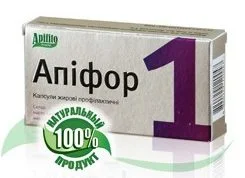
Apisarthron
A preparation in the form of an ointment or gel. Spread it on or rub it to the affected area.
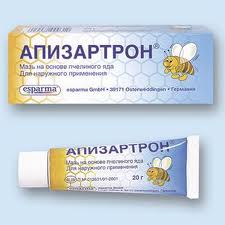
Ungapiven
An ointment based on bee venom. Rub it for about 5-10 minutes to the area of the most severe pain.
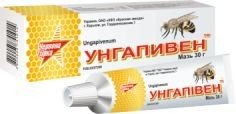
Venapiolinum
A preparation with bee venom in vegetable oil. Used as a painkiller and anti-inflammatory substance. 1ml ampoules. Venapiolinum 1 – bee venom sterile solution (from 2-3 bees) in 1 ml of vegetable oil. Venapiolinum 2 – a specially prepared volatile fraction of bee venom.
Virapin
Ampoules or ointment. Used for treatment of rheumatism, polyarthritis, various neuralgia types, radiculitis, sciatica.
911 +
An ointment with bee venom. Used as an auxiliary medicine in the treatment of osteoarthritis, radiculitis, and gout. Reduces pain and edema, and restores cartilage tissues. Has anti-inflammatory and antirheumatic effects. Improves joint mobility.
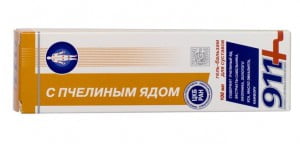
Apitoxin
A medicinal preparation in ampoules – a water solution of bee venom. It is effective for the treatment of diseases of the peripheral nervous system and radiculitis.
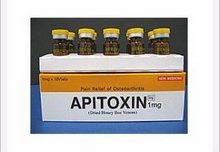
Apireven
An ointment containing bee venom. Used for treatment of acute chronic rheumatism, inflammation of the sciatic nerve, and lumbago. BEE VENOM CREAM – 30ml FAST RELIEF MUSCLE JOINT PAIN VERY EFFECTIVE. Ingredients: Petrolatum, lanolin, aqua, paraffinum liquidum, polysorbate 80, beeswax, glycerin 26, capsicum extract, camphor, methyl nicotinate, propolis extract, sodium tetraborate, bee venom. * Tested dermatologically
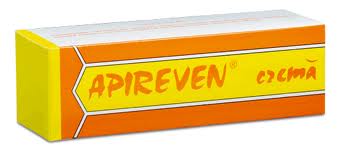
Venex, Bee venom ointment
VeneX® Bee venom ointment is made with honeybee venom.
An anti-inflammatory preparation containing honeybee venom (Apis Venenum Purum), and pure natural oils in a water-soluble (non-greasy) base.
Indications in the literature of bee venom include:
– chronic neuritis – degenerative arthropathy – functional disturbances of muscles, ligaments & tendinous insertions – lumbago – muscle warming prior to & during sports activities – myalgia – neuralgia – peripheral circulatory disturbances – sciatica – subchronic and chronic polyarthritis – sport injuries
Active Ingredients: Apis Venenum Purum (Honeybee Venom), Methyl Nicotinate, Oleum sinapis volatile, Oleum Terebinthinae, Piper nigrum oil and Proprietary Blend of pure essential oils. Ingredients of natural origin: 86.4%
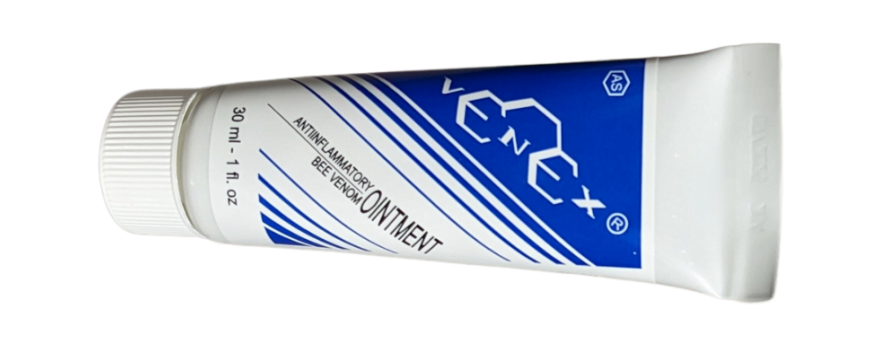
Apixin bee venom cream
Apixin is designed for the treatment of joints, muscles, lower back, neck, and shoulder pain. People can easily identify their symptoms with the product. It also contains more nature-identical ingredients that are EcoCert-approved and accepted as safe preservatives.
Apixin Cream is a multi-component anti-inflammatory preparation containing Grade I honeybee venom (Apis Venenum Purum), pure essential oils, ECOCERT approved preservatives in a water-soluble (non-greasy) base. Detailed ingredients list is on the label and in the user instructions. Ingredients of natural, or nature-identical origin: 93.75%. A 20 ml tube will last for a 7-10 days long treatment.
Field of Application:
Bee Venom Therapy, Electrophoresis/Iontophoresis (negative electrode), Physiotherapy/Massage Therapy, Sports Injuries, Chiropractic, Naturopathy, Athletic Therapy, Fitness Industry, Stiper Therapy, Ultrasonophoresis.
Ingredients:
Apis Venenum Purum (Honeybee Venom), Arnica montana infused oil, Methyl Nicotinate, Eugenol, Mentha piperita oil, Eucalyptus globules oil, Oleum sinapis volatile and Proprietary Blend of pure essential oils. Purified water, Sodium chloride, Phenoxyethanol*, Caprylyl Glycol*, Sorbic Acid*, Sodium Benzoate*, Potassium Sorbate*, Disodium EDTA in a Water-soluble base. Ingredients of natural, or natural identical origin: 93.75%.
